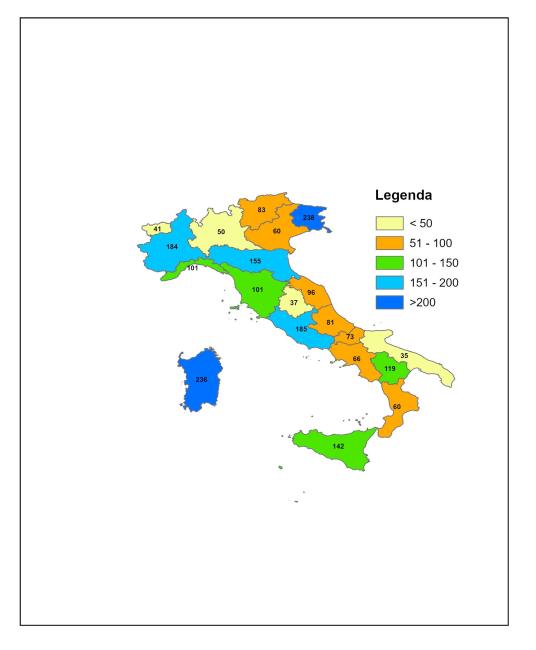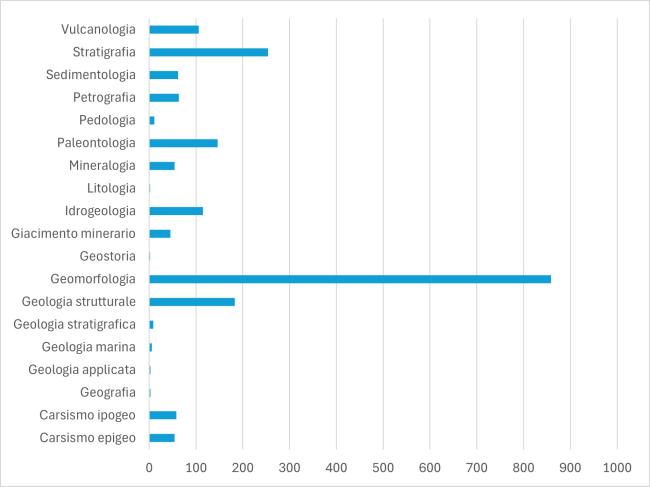Panel 1
Elisa Brustia, Mariapia Congi, Giovanni Finocchiaro, Roberto Pompili
The indicator represents the number of geosites, geological sites of such significance that they warrant conservation and protection, that have been identified, described, and inventoried in ISPRA’s Geosites database. As of September 30, 2024, approximately 2,030 geosites have been recorded.
Geosites constitute the fundamental element of geological heritage. These sites, of geological interest, are particularly important for reconstructing the geological history of the area where they are located, making their conservation a matter of interest. They include "geological singularities" (sites rich in fossils, minerals, landscape morphological elements, etc.) that, due to their rarity, scientific value, scenic beauty, and cultural and educational accessibility, can be considered true "geological monuments" to be protected, safeguarded, and enhanced.
Geosites represent the geodiversity of a territory, which is closely linked to biodiversity. The geological characteristics of the substrate influence the diversity of life that develops upon it and are, in turn, influenced by it. Thus, the conservation status of geodiversity affects biodiversity, making its protection essential to maintaining environmental balance.
The indicator reflects the Italian geosites that have been identified, described, and inventoried in ISPRA’s Geosites Database, which is publicly accessible at:
https://sinacloud.isprambiente.it/portal/apps/sites/#/inventario-nazionale-geositi-1
To provide a scientific description of Italian geosites, offering information on their significance for conservation purposes. Additionally, it aims to describe their lithological and environmental characteristics for their promotion and economic enhancement (geotourism) and to foster public awareness of geodiversity through educational initiatives.
There are no legal obligations for geosite conservation; however, key legislative references include:
- L 42/2004 and subsequent amendments, "Cultural Heritage and Landscape Code"
- L 9/2006 (Emilia-Romagna) "Regulations for the conservation and enhancement of geodiversity in Emilia-Romagna and related activities"
- L 39/2009 (Liguria) "Regulations for the enhancement of geodiversity, geosites, and karst areas in Liguria"
- L 33/2009 (Puglia) "Protection and enhancement of geological and speleological heritage"
- L 32/2015 (Basilicata) "Conservation and enhancement of geological heritage"
- L 15/2016 (Friuli-Venezia Giulia) "Provisions for the protection and enhancement of geodiversity, geological and speleological heritage, and karst areas"
- Veneto Regional Council Resolution No. 221/2017 "Census and cataloging of Veneto’s geosites and the establishment of the Regional Geosites Catalog"
- L.R. 30/2015 (Tuscany) "Regulations for the conservation and enhancement of the region’s naturalistic and environmental heritage"
- L.R. 23/2023 (October 6, 2023) "Provisions for the conservation, management, and enhancement of geological heritage"
Panel 2
J. Brilha, M. Gray, D.I. Pereira, P. Pereira, 2018. Geodiversity: An integrative review as a contribution to the sustainable management of the whole of nature. Environmental Science and Policy 86 (2018) 19–28
Díaz-Martínez, E., Brilha, J., Brocx, M., Erikstad, L., García-Cortés, A. & Wimbledon, W.A.P., 2016. Global Geosites: an active and partially achieved geoheritage inventory initiative, waiting to regain official recognition. In: Cornée, A., Egoroff, G., de Wever, P., Lalanne, A. & Duranthon, F. (eds.), Actes du congrès international «Les inventaires du géopatrimoine», 22-26 septembre 2015, Toulouse. Mémoire hors-série de la Société géologique de France, vol. 16, p. 103-108.
Gray (2013) - Geodiversity: Valuing and Conserving Abiotic Nature. 2nd Edition. Chichester, U.K.,
John Wiley & Sons. Wimbledon W.A.P. (1996a) – Geosites-a new conservation initiative. Episodes 19(3): 87-88.
Wimbledon W.A.P. (1996b) - National selection, a stop on the way to a European geosite list. Wimbledon W.A.P. & Smith-Meyer S. (eds) (2006) – Geoheritage in Europe and is conservation. ProGEO, 405 p.
http://whc.unesco.org/ World Heritage website
Giovagnoli, M. C. (2023). The Italian Geosite Inventory: Past, Present, and Future. Geoheritage, 15(2), 69.
A working group was established between ISPRA and eighteen Italian regions along with the two autonomous provinces to harmonize inventory criteria across the national territory and to identify classification standards for geosites. In 2021, the group produced a first draft of the Guidelines for Geological Heritage, which also include the criteria for the classification of geosites of international, national, regional, and local interest. Since 2022, these guidelines have been undergoing testing.
Data quality assessment
ISPRA (Italian Institute for Environmental Protection and Research)
Geodatabase Geositi dell'ISPRA (https://sinacloud.isprambiente.it/portal/apps/sites/#/inventario-nazionale-geositi-1).
National, Regional
2002 – September 30, 2024
Indicator assessment
The indicator requires simple algebraic and GIS analyses to determine numbers, percentages, and cartographic representations.
The goal of identifying geosites of major scientific interest nationwide in a uniform manner and describing their condition for conservation purposes is still a work in progress. However, interest and participation from local institutions continue to grow.
As of September 30, 2024, just over 2,030 geosites have been inventoried, around 70 fewer than the previous year, but the number is continuously changing (Figure 1). This reflects a rising environmental awareness among citizens, particularly regarding geodiversity. In collaboration with Italian regions, the entire inventory is being revised, and geosite records are being progressively updated. The total number of geosites is decreasing in favor of improved data quality.
Recent improvements to the inventory reveal a decrease in the total number of cataloged geosites, favoring higher-quality data and a more precise collection process. Consequently, the current depiction of Italy’s geosite landscape appears increasingly clear and detailed, indicating a positive trend.



Figure 1 highlights significant differences in regional distribution, which do not necessarily reflect a greater abundance of geological heritage but rather differences in the progress of geosite inventory projects across regions. In recent years, disparities between regions have gradually diminished, though substantial work remains, especially in areas where a lower number of geosites may suggest limited geodiversity—an inaccurate reflection of actual regional geological characteristics. Figure 2 illustrates that current national legislation does not contain specific provisions for the protection and management of geosites. Instead, relevant legal tools for geological heritage protection are found in laws and decrees regulating parks, reserves, and soil conservation. The drafting of territorial and/or landscape plans in accordance with Law 42/2004 (Codice Urbani) has played a fundamental role in encouraging local administrations to take an interest in geological heritage. This has promoted the protection and enhancement of recognized geosites, incentivizing some regions to adopt specific legislation in this regard. However, the absence of a national law remains noticeable. Even regional laws, with exceptions such as those in Emilia-Romagna and Friuli-Venezia Giulia, are sometimes ineffective. Regarding "primary scientific interest" (Figure 3), geomorphological geosites overwhelmingly dominate the inventory. Two key observations emerge: 1. Geomorphological geosites often possess landscape qualities that make them highly visible and easily recognizable. 2. The recognition of geosites under the Codice Urbani (L 42/2004) and their integration into local administrative planning have reinforced an approach that prioritizes geosites’ landscape value.